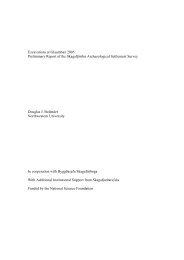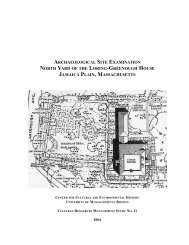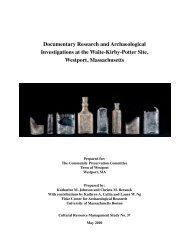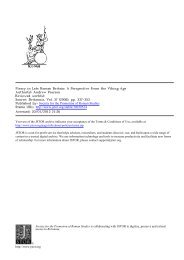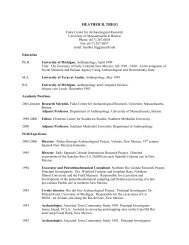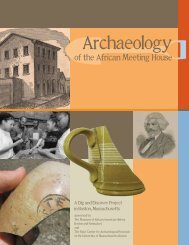Barrett, Locker and Roberts - Fiske Center
Barrett, Locker and Roberts - Fiske Center
Barrett, Locker and Roberts - Fiske Center
You also want an ePaper? Increase the reach of your titles
YUMPU automatically turns print PDFs into web optimized ePapers that Google loves.
James H. <strong>Barrett</strong>. Alison M. <strong>Locker</strong> & Callum M. Roherts<br />
changed with the times. For example, the economic complexity once associated with the end<br />
of the Viking Age is now attributed to the reign of Charlemagne (Hodges 1988; 2000).<br />
These changing perspectives have not, however, forged a consensus regarding when market<br />
trade of basic commodities really began on a meaningful scale. There now exist both 'early'<br />
(r. eighth century) <strong>and</strong> 'late' (tenth-eleventh century or later) schools of thought. Many<br />
histories of medieval economy continue to espouse the traditional end of the first millennium,<br />
or even the twelfth <strong>and</strong> thirteenth centuries, as the period of fundamental economic change<br />
- including the growth of trade <strong>and</strong> urbanism (Andrcn 1989:593-594; Saunders 1995:42-<br />
50; Moore 2000:30-39; Dyer 2002:101; Spufford 2002:12; Griffiths 2003:97-104). Moreover,<br />
given the scattered source material, historical studies of market trade in earlier centuries are<br />
seldom able to quantify the relative scale of this activity vis-a-vis later developments. This<br />
problem is critical. Almost fifty years ago, Crierson (1959) Lincquivocally demonstrated that<br />
market <strong>and</strong> non-market trade coexisted in early medieval Europe. Answering the question<br />
'when did fundamental economic change really happen?' thus becomes a matter of assessing<br />
the degree of market trade, or more realistically, of the relative importance of staple over<br />
prestige goods in exchange transactions (<strong>Barrett</strong> et al. 2000:15).<br />
l~he present paper addresses this last critical issue, k asks when an unambiguously low-value,<br />
high-bulk, product - marine fish - was first harvested <strong>and</strong> traded on a large scale in medieval<br />
Engl<strong>and</strong>. In doing so, it is possible to provide one measure of the character <strong>and</strong> chronology of the<br />
distinction between 'Dark Age' <strong>and</strong> high medieval economy. Previous work in Scotl<strong>and</strong> (e.g.<br />
<strong>Barrett</strong> 1997) has demonstrated the potential offish bone evidence to answer questions of this<br />
kind, <strong>and</strong> here we apply similar methods to the issue of economic change in medieval Engl<strong>and</strong><br />
<strong>and</strong> its European context. We argue that the most important change in English fishing between<br />
AD 600 <strong>and</strong> 1600 occurred within a few decades of AD 1000 <strong>and</strong> involved large relative increases<br />
in catches of herring [Clupea harengns) <strong>and</strong> cod {Gadus morhiia), many of which were probably<br />
distributed by trade. It has long been suspected that marine fishing increased at some point in the<br />
Middle Ages (Jones 1981, 1988; <strong>Locker</strong> 1988a), but the chronology, clarity <strong>and</strong> rapidity of the<br />
trend can now be fijily appreciated. Sea fish were caught <strong>and</strong> transported to inl<strong>and</strong> sites, such as<br />
the proto-urban 'wic' of York, in earlier centuries, but the change in scale of this activity around<br />
the end of the first millennium is remarkable. Evidence of similar developments is slowly emerging<br />
across Europe, from the Baltic Sea region to the Northern Isles of Scotl<strong>and</strong> (<strong>Barrett</strong> et ai 2000;<br />
EnghofF2000; Van Neer & Ervynck 2003). Although it is uncontroversiiil that the importance of<br />
trade incre;Lsed in tenth <strong>and</strong> eleventh centur)' Europe {Fossier 1999:27; Griffiths 2003), it has<br />
rarely been possible to qtiantif)' the relative scale of activity either side of AD 1000 - <strong>and</strong> thus to<br />
contextualise the significance of'Dark Age' commerce.<br />
y<br />
g<br />
u<br />
Identifying medieval fish trade<br />
With a few exceptions, syntheses of early medieval economic history have largely ignored<br />
fish trade {cf Hodges 1982; Dyer 2002; Verhulst 2002). For historians, the reason is clear.<br />
They are limited to discussing the earliest written evidence rather than the origin of the<br />
practice itself. In an English context, most discussion begins in the thirteenth <strong>and</strong> fourteenth<br />
centuries with very limited inference possible from earlier sources (Nedkvitne 1976; Childs<br />
& Kowaleski 2000; Kowaleski 2000; Fox 2001). In Scotl<strong>and</strong>, tbe earliest detailed historical<br />
evidence is of fifteenth century date (Friedl<strong>and</strong> 1983; McNeill & MacQueen 1996:241). In<br />
619



